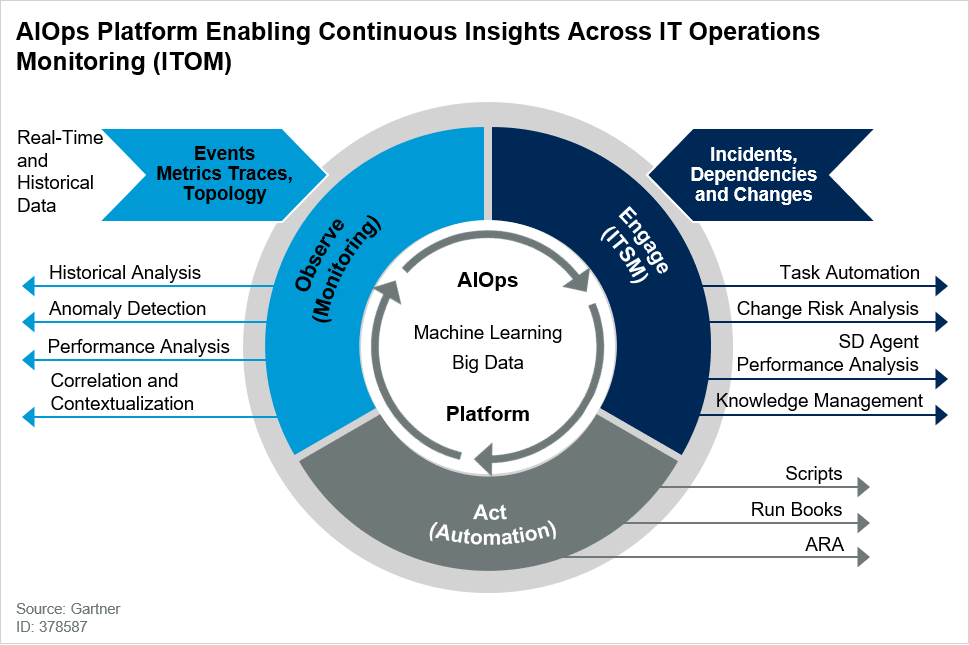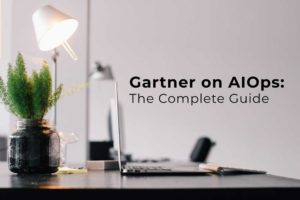Gartner’s Perspective on AIOps: An In-Depth Guide
The global market is moving fast, and the world’s I&O (infrastructure and operations) leaders are looking to enhance their decision-making capabilities with the contextualization and consolidation of large volumes of data to get ahead of the competition.
The future of digital transformation for businesses lies in the hands of AIOps commonly categorized as domain-agnostic, domain-centric, or DIY. AIOps platforms are being leveraged for their performance analysis and augmentation of IT service management and automation.
Gartner’s market guide for AIOps details the most important things to know about the current state and future of AIOps. This complete guide to Gartner on AIOps is your most comprehensive guide to make sure you know everything you need to know about AIOps platforms and tools.
“By 2023, 40% of DevOps teams will augment application and infrastructure monitoring tools with artificial intelligence for IT operations (AIOps) platform capabilities.” – Gartner Market Guide for AIOps Platforms, November 2019
What is AIOps?
Gartner describes AIOps platforms as tools used, especially by I&O leaders, to support and enhance operations functions with heavy strength and emphasis on machine learning, data science, and analytics. These platforms leverage technologies like big data, machine learning, and process automation for in-depth analysis of high-volume and high-variety data coming from IT. They also support IT operations with functions such as root-cause analysis, event correlation, detecting anomalies, and automating other core functions.
What are the main and most notable functions of AIOps platforms?
- Take in (ingest) and analyze data from different areas in the existing enterprise environment such as infrastructure, apps, other monitoring systems, and networks
- Analyze both real-time and stored historical data using machine learning
- Remediating and taking proactive next steps or actions from resulting prescriptions
Ingestion of data is a key necessity of AIOps platforms; they must be able to ingest, index, and store a wide variety of data and metrics as well as graph and document it all. In addition, real-time analysis at the point of ingestion is what makes AIOps so powerful. With this type of real-time analysis, AIOps platforms do not need to wait for data to be saved and stored in a database to retrieve it — it’s ready as soon as it happens.
Analysis by machine learning in AIOps uses different types of approaches. Statistical analysis uses clustering, correlation, classification, and extrapolation for different IT metrics. Automated pattern recognition/discovery and prediction sorts through data to predict incidents. Anomaly detection then uses incident prediction to discern normal and abnormal behavior across the incoming data and environments. Root cause determination finds correlation networks from recognized patterns to pinpoint cause-and-effect relationships. Topological analysis provides deep and detailed insight for staff to focus their efforts on remediation. Prescriptive advice is simple: it suggests what to do to resolve an issue.
Remediation takes into account all of the prescriptive data and suggestions from the machine learning analysis and translates that into automated, realistic, and actionable processes.

What are the different types of AIOps?
Now that you’ve familiarized yourself with the main capabilities of AIOps, you can dive deeper into what is the most important part of this complete guide to Gartner AIOps. There are three types of AIOps platforms: domain-agnostic, domain-centric, and do-it-yourself (DIY). Knowing and understanding these three types will help you get a better vision of AIOps as well as help you pick the right one for your enterprise.
Domain-agnostic AIOps are very useful tools because they are flexible, general-purpose platforms that are able to ingest large varieties and volumes of data, creating excellent value for enterprises. They easily and effectively take data from integrated monitoring tools to capture data and apply a wide range of use cases.
Domain-centric AIOps tend to have a more limited range of use cases in an enterprise context. As the name suggests, domain-centric AIOps revolve around one specific domain such as a network or endpoint system. They are essentially restricted to certain sets of data sources and data types. This can be a speed bump that inhibits the optimal performance of AIOps.
Do-It-Yourself AIOps, fittingly, is for enterprises that prefer to build their own AIOps platforms from the ground up to address their specific needs and applications. There are open-source tools and projects out there that provide the plug-and-play utility that the engineers can then implement into their own enterprise AIOps platforms. These DIY projects are fairly uncommon because they require loads of the right talent and an abundance of skills to get the job done correctly.
“Gartner estimates the size of the AIOps platform market at between $300 million and $500 million per year.” – Gartner Market Guide for AIOps Platforms, November 2019
Benefits of Domain-Agnostic AIOps
This guide to Gartner AIOps would not be complete without explaining the clear benefits of domain-agnostic AIOps:
Full-stack observability: Having a domain-agnostic AIOps means that it will draw from a myriad of different applications such as computation, infrastructure, databases, services, and more. A good domain-agnostic AIOps platform brings a level of accessibility and visibility to the applications stack, maintaining the balance of high service quality, reliability, and performance.
Alert noise suppression: High volumes of alerts can create too much noise and drown out the most important signals. With the right AIOps, you’ll be able to receive pinpointed alerts for the ones that actually matter.
Predictive major incidents: Early and rapid detection of outages or incident symptoms allows for the remediation of these problems before they scale into full-on major incidents.
Runbook automation: Intelligent automation powered by AI and machine learning is what makes AIOps such an effective tool for enterprises. Automation of verification and remediation will streamline and quickly resolve issues, minimizing errors and improving MTTR.
The Future of Domain-Agnostic AIOps
Not only is AIOps the future of digital transformation, but domain-agnostic AIOps is one of the strongest drivers moving forward. Without the limitations of being restricted to one specific domain, domain-agnostic AIOps can cover the full scope of IT operations and more.
The purpose of this guide to Gartner on AIOps is to educate and inform everyone of this crucial technological shift for operations. It’s important for organizations to understand the sheer power of domain-agnostic AIOps so that they can fully optimize the internal operations of their core functions.
Aisera, named a leader in the 2023 Forrester Wave AIOps Report for a process-centric approach to IT Operations, offers the world’s premier domain-agnostic AIOps platform for IT/Cloud/DevOps.
This platform comes with out-of-the-box capabilities that include full-stack observability, alert noise suppression, the transition from reactive alerts to predictive major incidents, dynamic CMDB and probabilistic service maps, causal graph and root-cause analysis, and runbook automation.
The Aisera AIOps platform effectively transforms outdated and inefficient operations into a flexible, dynamic, and user-friendly tool that boosts business uptime, reduces costs, and enhances MTTR.

